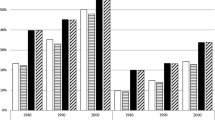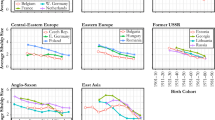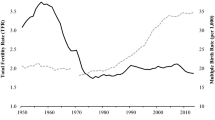Abstract
The child quality-quantity debate pays extensive attention to the effect of sibship size on education, but less is known about other outcomes of children such as health and labor. In this study, we estimate the effect of sibship size on various outcomes of children including disability, education and the labor supply of children in Vietnam. We do not find significant effects of sibship size on disability and working status of children. However, we find that having an additional sibling increases the risk of dropping out of school. More specifically, having an additional sibling reduces the probability of schooling of the first-born children by 1.6 percentage points in families with at least a child. This effect is increasing to around 3.0 percentage points in families with at least three children. The effect of sibship size on the number of completed grades is also higher and more significant in large families.
Similar content being viewed by others
Notes
The two-child policy was strictly applied to civil servants and worker sin the public sector. People who violated the policy were not promoted and received a wage reduction (Pham et al. 2012).
UNFPA has assisted in testing, piloting, training and monitoring the survey process, including the design of the questionnaires,
According our estimates from the 2009 VHPC, Vietnam consists of 54 ethnic groups, in which Kinh or Vietnamese accounts for 85% of the total population. Compared with ethnic minorities, Kinh people have higher income and living standards (e.g., Lanjouw et al. 2017).
We used command ivreg2 in Stata to estimate the 2SLS regression and performance tests. As a rule of thumb, if a F- statistic is under 10, the instruments might be weak (Staiger and Stock 1997).
We also tried the two instruments (twins and sex of the firstborn) in the regressions with interactions. It means that instruments for interactions between sibship size and individual characteristics are interactions between the two instruments and individual characteristics. The estimation results are similar to those using one instrument of twins. Therefore, we report the estimates using one instrument ‘presence of twins’.
References
Angrist, J. (2001). Estimation of limited dependent variable models with dummy endogenous regressors: Simple strategies for empirical practice. Journal of Business & Economic Statistics, 29(1), 1–28.
Angrist, J., & Krueger, A. B. (2001). Instrumental variables and the search for identification: From supply and demand to natural experiments. Journal of Economic Perspectives, 15(4), 69–85.
Angrist, J., & Pischke, J. (2008). Mostly harmless econometrics: An empiricist's companion. Princeton University Press.
Angrist, J., Lavy, V., & Schlosser, A. (2010). Multiple experiments for the causal link between the quantity and quality of children. Journal of Labor Economics, 28(4), 773–823.
Anh, T. S., Knodel, J., Lam, D., & Friedman, J. (1998). Family size and children’s education in Vietnam. Demography, 35(1), 57–70.
Arouri, M., Ben-Youssef, A., & Nguyen, C. V. (2019). Ethnic and racial disparities in children's education: Comparative evidence from Ethiopia, India, Peru and Viet Nam. Children and Youth Services Review, 100, 503–514.
Becker, G. S. (1960). An economic analysis of fertility. In G. S. Becker (Ed.), Demographic and Economic Change in Developed Countries. Princeton: Princeton University press.
Becker, G. S., & Lewis, H. G. (1973). On the interaction between the quantity and quality of children. Journal of Political Economy, 81(2), 279–288.
Becker, G. S., & Tomes, N. (1976). Child endowments and the quantity and quality of children. Journal of Political Economy, 84(4), 143–162.
Belmont, L., & Marolla, F. A. (1973). Birth order, family size, and intelligence. Science, 182(4117), 1096–1101.
Black, S. E., Devereux, P. J., & Salvanes, K. G. (2005). The more the merrier? The effect of family size and birth order on children's education. The Quarterly Journal of Economics, 120(2), 669–700.
Blake, J. (1981). Family size and the quality of children. Demography, 18(4), 421–442.
Blake, J. (1989). Family size and achievement. Berkeley: University of California Press.
Booth, A. L., & Kee, H. J. (2009). Birth order matters: The effect of family size and birth order on educational attainment. Journal of Population Economics, 22(2), 367–397.
Cáceres-Delpiano, J. (2006). The impacts of family size on investment in child quality. Journal of Human Resources, 41(4), 738–754.
Cappa, C., Petrowski, N., & Njelesani, J. (2015). Navigating the landscape of child disability measurement: A review of available data collection instruments. ALTER-European Journal of Disability Research/Revue Européenne de Recherche sur le Handicap, 9(4), 317–330.
Cigno, A., & Rosati, F. C. (2002). Child labour education and nutrition in rural India. Pacific Economic Review, 7(1), 65–83.
Cummings, P., Theis, M. K., Mueller, B. A., & Rivara, F. P. (1994). Infant injury death in Washington state, 1981 through 1990. Archives of Pediatrics & Adolescent Medicine, 148(10), 1021–1026.
Dang, H. A. H., & Glewwe, P. W. (2018). Well begun, but aiming higher: A review of Vietnam’s education trends in the past 20 years and emerging challenges. Journal of Development Studies, 54(7), 1171–1195.
Dayioğlu, M., Kirdar, M. G., & Tansel, A. (2009). Impact of sibship size, birth order and sex composition on school enrolment in urban Turkey. Oxford Bulletin of Economics and Statistics, 71(3), 399–426.
De Haan, M. (2010). Birth order, family size and educational attainment. Economics of Education Review, 29(4), 576–588.
Deb, P., & Rosati, C. (2004), Estimating the effect of fertility decisions on child labor and schooling. Understanding Children's Work Programme Working Paper. Available at SSRN: https://ssrn.com/abstract=1780272, Estimating the Effect of Fertility Decisions on Child Labor and Schooling
Downey, D. B. (1995). When bigger is not better: Family size, parental resources, and children’s educational performance. American Sociological Review, 60, 746–761.
Filmer, D. (2008). Disability, poverty, and schooling in developing countries: Results from 14 household surveys. The World Bank Economic Review, 22(1), 141–163.
Giang, L. T., Nguyen, C. V., Tran, T. Q., & Thieu, V. (2017). Does firm agglomeration matter to labor and education of local children? Evidence in Vietnam. Child Indicators Research, 10(4), 1015–1041.
Glick, P. J., Marini, A., & Sahn, D. E. (2007). Estimating the consequences of unintended fertility for child health and education in Romania: An analysis using twins data. Oxford Bulletin of Economics and Statistics, 69(5), 667–691.
GSO. (1999). Population and housing census in 1999. Hanoi: General Statistics Office.
GSO. (2018). Statistical year book 2017, general statistical Office of Vietnam (GSO). Hanoi: Publisher of Statistics.
Haveman, R., & Wolfe, B. (2000). The economics of disability and disability policy. Handbook of Health Economics, 1, 995–1051.
Henderson, D. J., Millimet, D. L., Parmeter, C. F., & Wang, L. (2008). Fertility and the health of children: A nonparametric investigation. In Modelling and Evaluating Treatment Effects in Econometrics (pp. 167–195). Emerald Group publishing limited.
ILO, MOLISA and GSO. (2014). Viet Nam national child labour survey 2012 Main findings. In Joint report from International Labour Organization (ILO), Ministry of Labour, Invalids and Social Affairs of Vietnam (MOLISA) and General Statistics Office of Vietnam (GSO). Hanoi.
Jernström, L. (2017). The marginal effects of family size on Children’s health in Vietnam–does the effect of siblings differ by parity? Master Thesis: Faculty of Social Sciences, University of Helsinki, Finland.
Khan, N. Z., Ferdous, S., Mahbub, M., Mobarak, R., Parveen, M., Mont, D., & Durkin, M. (2011). The impact of maternal and household characteristics on childhood impairments and disabilities in Bangladesh. Bangladesh Journal of Child Health, 35(2), 41–48.
Kruger, R., Kruger, H. S., & Macintyre, U. E. (2006). The determinants of overweight and obesity among 10-to 15-year-old schoolchildren in the north West Province, South Africa–the THUSA BANA (transition and health during urbanisation of south Africans; BANA, children) study. Public Health and Nutrition, 9(3), 351–358.
Lanjouw, P., Marra, M., & Nguyen, C. (2017). Vietnam’s evolving poverty index map: Patterns and implications for policy. Social Indicators Research, 133(1), 93–118.
Lee, J. (2008). Sibling size and investment in children’s education: An Asian instrument. Journal of Population Economics, 21(4), 855–875.
Li, H., Zhang, J., & Zhu, Y. (2008). The quantity-quality trade-off of children in a developing country: Identification using Chinese twins. Demography, 45(1), 223–243.
Madans, J. H., Loeb, M., & Altman, B. (2010). Measuring disability and monitoring the UN convention on the rights of persons with disabilities: The work of the Washington group on disability statistics. BMC Public Health, 11(Suppl 4), 1–8.
Minh, T. 2016. “Tỷ Lệ Sinh Con Thứ 3 Tiếp Tục Tăng”, Sai Gon Giai Phong newspaper, 30/7/2016. Available at: http://www.sggp.org.vn/ty-le-sinh-con-thu-3-tro-len-tiep-tuc-tang-26330.html. Accessed 20 June 2017
Mitra, S. (2006). The capability approach and disability. Journal of disability policy studies, 16(4), 236–247.
Mogstad, M., & Wiswall, M. (2016). Testing the quantity–quality model of fertility: Estimation using unrestricted family size models. Quantitative Economics, 7(1), 157–192.
Mont, D., & Cuong, N. V. (2011). Disability and poverty in Vietnam. The World Bank Economic Review, 25(2), 323–359.
Mont, D., Cappa, C., Bahadur, C. N., Dorji, C., Hingst, G., & Khan, N. (2014). Poverty, maternal education and child disability: Evidence from Bhutan. Disability and International Development, 3, 13–20.
Nguyen, C. V. (2016). Does parental migration really benefit left-behind children? Comparative evidence from Ethiopia, India, Peru and Vietnam. Social Science & Medicine, 153, 230–239.
Park, C., & Chung, W. (2012). Sibship size, birth order, and children's education in developing countries: Evidence from Bangladesh. Hitotsubashi Journal of Economics, 53, 1–23.
Patrinos, H. A., & Psacharopoulos, G. (1997). Family size, schooling and child labor in Peru–an empirical analysis. Journal of Population Economics, 10(4), 387–405.
Peters, C., Rees, D. I., & Hernández-Julián, R. (2014). The trade-off between family size and child health in rural Bangladesh. Eastern Economic Journal, 40(1), 71–95.
Pham, B. N., Hill, P. S., Hall, W., & Rao, C. (2012). The evolution of population policy in Viet Nam. Asia-Pacific Population Journal, 27(2), 41–56.
Ponczek, V., & Souza, A. (2011). New evidence of the causal effect of family size on child quality in a developing country. Journal of Human Resources, 47(1), 64–106.
Ponsonby, A. L., Couper, D., Dwyer, T., & Carmichael, A. (1998). Cross sectional study of the relation between sibling number and asthma, hay fever, and eczema. Archives of Disease in Childhood, 79(4), 328–333.
Qian, N. (2009). Quantity-quality and the one child policy. In The only-child disadvantage in school enrollment in rural China, NBER working papers no. 14973. Massachusetts: National Bureau of economic research.
Rona, R. J., Duran-Tauleria, E., & Chinn, S. (1997). Family size, atopic disorders in parents, asthma in children, and ethnicity. Journal of Allergy Clinical Immunology, 99(4), 454–460.
Rosenzweig, M. R., & Wolpin, K. I. (1980). Testing the quantity-quality fertility model: The use of twins as a natural experiment (pp. 227–240). XLVIII: Econometrica.
Rosenzweig, M. R., & Zhang, J. (2009). Do population control policies induce more human capital investment? Twins, birth weight and China's “one-child” policy. The Review of Economic Studies, 76(3), 1149–1174.
Sarin, A. (2004). Are children from smaller families healthier? Examining the causal effects of on child welfare. Paper presented at the population association meetings in Boston, April 3. Harris Policy School, University of Chicago.
Schneider, M. (2009). The difference a word makes: Responding to questions on 'disability' and 'difficulty' in South Africa. Disability and Rehabilitation, 31(1), 42–50.
Scholer, S. J., Mitchel, E. F., & Ray, W. A. (1997). Predictors of injury mortality in early childhood. Pediatrics, 100(3), 342–347.
Schultz, T. P. (2005). Effects of fertility decline on family well being: Opportunities for evaluating population programs. Working Paper, http://www.econ.yale.edu/~pschultz/.
Schwartz, S., Eidelman, A. I., Zeidan, A., Applebaum, D., & Raveh, D. (2005). Childhood accidents: The relationship of family size to incidence, supervision, and rapidly seeking medical care. Israeli Medical Association Journal, 7(9), 558–563.
Staiger, D., & Stock, J. (1997). Instrumental variables regression with weak instruments. Econometrica, 65(3), 557–586.
WHO. 2011. World Report On Disability, WHO press, World Health Organization, 20 avenue Appia, 1211 Geneva 27, Switzerland.
Yucel, D., & Yuan, A. V. (2015). Do siblings matter? The effect of siblings on socio-emotional development and educational aspirations among early adolescents. Child Indicators Research, 8(3), 671–697.
Zajonc, R. B. (1976). Family configuration and intelligence. Science, 19, 227–236.
Zajonc, R. B. (2001). The family dynamics of intellectual development. American Psychologist, 56(6/7), 490–496.
Zajonc, R. B., & Markus, G. (1975). Birth order and intellectual development. Psychological Review, 82, 74–88.
Author information
Authors and Affiliations
Corresponding author
Additional information
Publisher’s Note
Springer Nature remains neutral with regard to jurisdictional claims in published maps and institutional affiliations.
Appendix
Appendix
Rights and permissions
About this article
Cite this article
Mont, D., Nguyen, C.V. & Tran, A. The Effect of Sibship Size on Children’s Outcomes: Evidence from Vietnam. Child Ind Res 13, 147–173 (2020). https://doi.org/10.1007/s12187-019-09673-z
Accepted:
Published:
Issue Date:
DOI: https://doi.org/10.1007/s12187-019-09673-z




